An unsuccessful mating involves a repeat mating, and a successful conception involves careful monitoring of the expectant mother to help prevent the development of abnormalities. In both situations, the owner is required to understand the exact signs appearing in the pregnant animal.
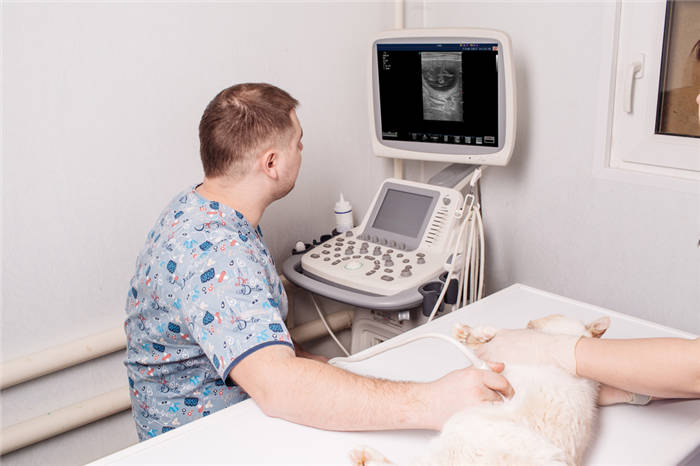
- How to understand that the cat is giving birth: the first harbingers of an impending birth
- Harbingers of an imminent birth
- Signs occurring a week before labor
- Harbingers of labor in sphinxes
- Signs of the beginning of labor
- Appearance of kittens
- Preparing for birth
- Signs that the birth is coming
- Harbingers of an imminent labor
- The first birth of a cat: signs of labor, stages
- Signs of cat labor
- Symptoms to watch out for
- Help for the pet in case of complications
- Taking care of an expectant mother
- Diet and vitamins
- Arrange your birthing space
- Is it possible to terminate a pregnancy?
- How do you know if something has gone wrong and the animal needs help?
- Discharges after delivery
- Large belly in a cat that has given birth
- Lack of milk in a cat
- The birth is over. What's next?
How to understand that the cat is giving birth: the first harbingers of an impending birth
Every animal is individual and the pregnancy period in domestic cats is no exception. It is possible to understand that the cat is giving birth, if you carefully observe your pet.
The normal physiological process of carrying kittens lasts on average 65 to 68 days. At the end of the term, the delivery comes, and the owner should orient when the important day comes, in order to prepare in advance to receive the kittens.About a week or 4-6 days before the expected date, it is necessary to prepare a place for the birth mother and its further stay there with the offspring.
Harbingers of an imminent birth
As in the process of carrying kittens, the period of labor onset and the harbingers of labor can vary depending on the cat's breed, weight, age, and health status. For example, for some cats, the harbingers begin several days before labor day, and for others a few hours before the first kitten comes out.
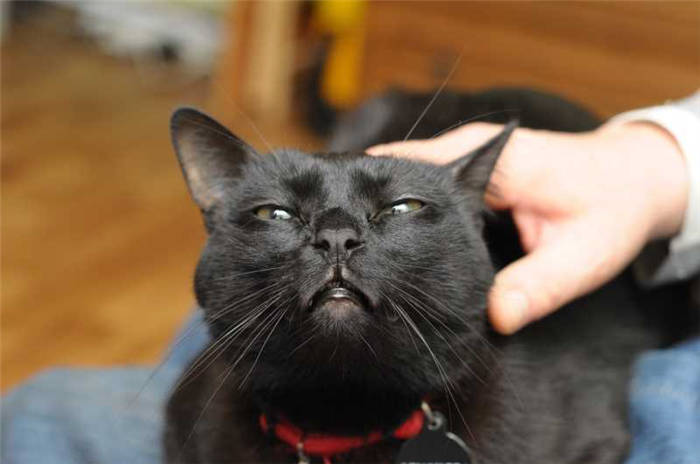
The main signs that a cat is about to give birth are:
- Searching for the calving nest;
- The animal tries to find a secluded, secluded place;
- Constantly cuddles up to its owner;
- thoroughly licks the abdominal and crotch areas;
- The mammary glands increase in volume (it is not uncommon for the first born milk to appear – colostrum);
- decrease in body temperature to 37 degrees, while the normal temperature is 38-39.2;
- The release of mucous plug;
- Abstraction of water.
Signs occurring a week before labor
In normal animals that are physically healthy and of normal gestation, the symptoms of the beginning of labor appear a week before the process itself. The signs should not go unnoticed by the owner and it is time to prepare for calving.
The onset of early labor is marked by the presence of the following signs:
Harbingers of labor in sphinxes
Don and Canadian sphynxes are exemplary and caring mothers for their little kittens. The gestation period lasts from 58 to 72 weeks. In most cases, the cats of this breed give birth to 3 to 5 kittens per calving.
The first signs of birth in sphinxes appear 2 days before the upcoming event. Two days before parturition the temperature in the rectal passage drops to 36.7 degrees. The cat begins to actively nurse and scrub the genital area.
A few hours before labor, the cat begins to arch its back and show pronounced anxiety. Otherwise, the signs of the beginning of labor are similar to other cat breeds, and the birth process itself takes about 12 hours until the last kitten comes out.
Please note! If contractions last longer than 3-4 hours without a push, you need to contact a veterinarian for help.
Signs of the beginning of labor
The day before the start of labor in a cat signs that appeared earlier, supplemented by another – a decrease in body temperature by 1 ° C. If a pet is used to measuring the temperature regularly, this method will help to determine as accurately as possible the proximity of parturition. If this procedure is new to the owner and the mother in labor, it is better not to start it at such a time, and just leave the animal alone.
Before delivering a cat, be sure to prepare a "rescue" set of tools and supplies, including:
- antiseptic and disinfectant;
- scissors, dental floss;
- Pipette, baby syringe, disposable syringes
- surgical gloves
- gauze wipes;
- Vaseline;
- toilet paper;
- garbage bags;
- diaper;
- heater;
- a stopwatch.
You should also have the phone number of a vet on hand. All this may not be necessary, but it is better to be prepared for any development of the situation.
The immediate beginning of the labor process will be indicated by rapid breathing and the first contractions, during which the mother usually meows and reaches for the back with her teeth. This stage may last from a few hours to a day. During this time, the animal should not be disturbed, and especially do not arrange for crowded viewings, as excessive attention may cause the cat to eat the newborn cubs.
Appearance of kittens
Let's tell you how birth occurs in domestic cats. The first sign of an impending kitten birth is lighter and then darker discharge, followed a little later by pushing. The kitten is born about 25-35 minutes after the onset of these manifestations. The baby comes into the world in the amniotic sac, which the cat bites down on and then licks its snout to remove mucus and open its nose for breathing. It then chews the umbilical cord and licks the entire calf, activating blood flow and other vital functions.
Depending on how the cat's labor is going, you either need to stay out of it or start helping. If the birthing mother manages to "handle" each kitten before the next one arrives, nothing needs to be done. When she has not coped with one, and the birth of another baby has already begun, the algorithm of actions should be as follows:
If there is no breathing, the airway should be cleaned with a baby syringe. If this does not help – gently turn the baby upside down with the tail, supporting the head, and bend slightly, stimulating the outflow of fluid.
Preparing for birth
Often pets give birth so quietly and gently that the owner does not even have time to notice any traces of the event. But in case of complications the pet may need human help, so it is better to find out in advance how to determine if the cat is giving birth, and to prepare carefully for this event.
By the end of the third trimester of pregnancy the caring owner should stock up on items and medications that may come in handy during the birth, and immediately afterwards. So, if you are worried about the health of your pet and her future babies, you must have them on hand at the time of calving:
- Oxytocin, a drug that stimulates labor, in case it is delayed.
- Sterile latex gloves.
- Sterile scissors and floss.
- Antiseptics in powder and liquid form for animals.
- Green cloth and cotton balls for treating the umbilical cord.
- Special suction, pear or pipette to remove fluid from kitten's airway if she begins to choke.
- Clean terry towels for wiping kittens.
- A veterinarian's phone number for an emergency consultation.
- Cat's milk substitute (she may not have it).
- Sturdy cardboard box for kittens with low sides (whether you buy it at a pet store or make it yourself – the main thing is that the cat can freely "travel" in and out of it without disturbing the kittens).
Signs that the birth is coming
So, you have already prepared and bought everything you need, and now you have to wait for birth. And then the question arises again: How to understand that the cat gives birth, the signs of the end of pregnancy are obvious, but the inexperienced owner needs more information, to be able to come to the aid at the right moment.
- the animal is very restless, meows loudly, looks for a comfortable, often hidden place to allow the breeding;
- The mammary glands greatly increase in size and the skin around the nipples is dry and flaky;
- 24 hours before calving, the pet is lactating;
- Body temperature drops to 37 degrees or lower;
- On the day of calving the cat loses interest in food altogether;
- A few hours before calving the cat begins to arch her back frequently;
- the animal licks genitals, that often give off a malodorous smell (sometimes you can notice a mucus plug, which is a transparent or pinkish, yellowish and even greenish clot, but usually an animal "takes out" a plug, that comes out piece by piece, together with excretions).
The withdrawal of the plug and an actively "moving" abdomen indicate that the pet is about to go into labor or has already gone into labor.
Harbingers of an imminent labor
It is customary to divide a cat's labor into three stages. The onset of the first stage of labor is called precursors. Normally, a mucus plug comes out of the birth canal before labor begins. However, you should not rely on this sign for several reasons. The mucus plug can be very small and come out during urination. This process will be invisible not only to you, but also to the expectant mother. Moreover, many experienced owners tell that they have observed the rejection of the mucus plug a few weeks before labor.
The first contractions occur up to 30-40 minutes apart. There is little pain, so the cat may behave as usual except for being more anxious. As the contractions intensify, the mother-to-be will ignore food and stay close to the nest. Most often during the first contractions the cat is active, you might say eager to drink water. You may notice that the cat frequently goes to the litter box but does not empty its bladder and bowels. This behavior is due to a pulling pain in the peritoneum, which is a bit like a urge to urinate and defecate.
The movement of the first kitten toward the birth canal can provoke urges to defecate. Most cats go to the litter box to relieve their need. If you notice that the cat has already started contractions and has gone to the litter box, be careful that no fetal bladder appears in the birth canal during defecation. If this happens, gently take the cat in your arms and carry her to the nest.
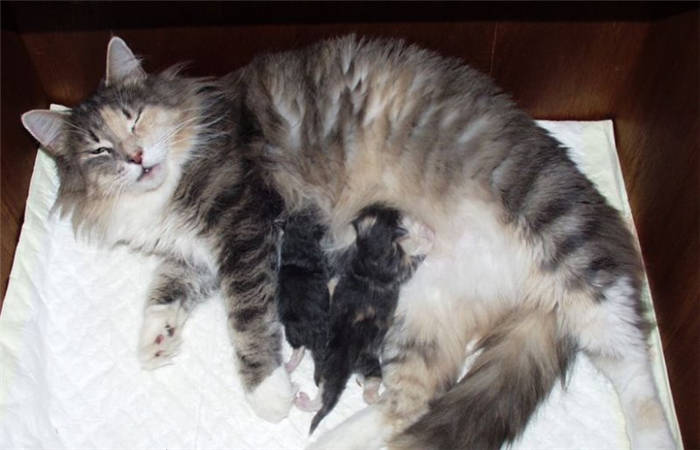
The contractions become evident after the onset of phase 2 of the first stage of labor. The peritoneum is almost constantly in tension, muscle contractions can be seen visually and well palpated. At this stage the cat breathes frequently and shallowly, tries to lie on its side and lick itself. Normally, after the beginning of strong contractions and before the onset of pushing, it will take no more than an hour.
The first birth of a cat: signs of labor, stages
What are the difficulties to expect if the first delivery in a cat is coming? What signs indicate the imminent birth of kittens? Can you cope on your own or is it better to turn to a veterinary obstetrician? Let's look into all the questions below.
Taking care of a pregnant cat can seem like a complicated process, especially if you are inexperienced in the matter. In fact, in most cases, pregnancy in a cat proceeds naturally and often unnoticed to the owner.
Of course, if the pregnancy is planned, the health of the expectant mother should be monitored by a veterinarian. In addition, prior to a scheduled mating, both parents should receive worming prophylaxis and a full range of vaccinations. If you're not sure you're ready for kittens, your cat has no breeding value, and mating is not supervised by a breed club, it's best to keep your pet pregnant.
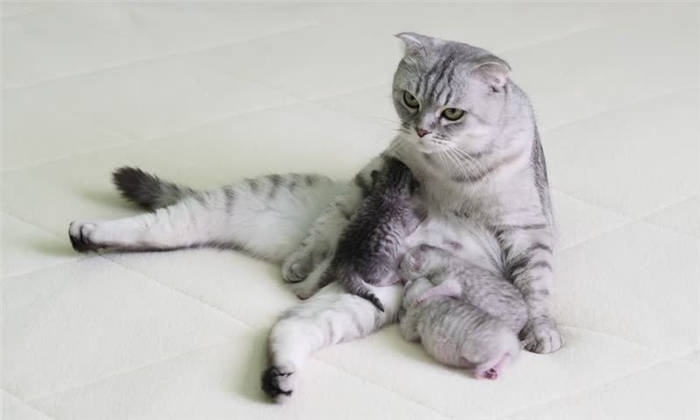
If your pet is pedigree-free, it makes more sense to spay her before she enters puberty. Neutering a cat after the first delivery is also acceptable, but:
- You will have kittens whose fate you are responsible for.
- Your cat will have to endure the stress of pregnancy and childbirth.
- The cat's body will undergo a long process of hormonal balancing.
- After giving birth the cat will be weakened and may have a harder time with sterilization.
- An old cat (and a young cat as well) may have complications during delivery and afterwards.
It happens that cat owners become hostage to the situation, that is, they find out that their cat is pregnant after the fact. Many owners think that the young age of the cat is a barrier to carrying the offspring. Be vigilant, however, because mongrel cats can become sexually active at five to six months of age. Such a young body is not ready for the stresses associated with pregnancy, and this is fraught with problems during pregnancy.
Signs of cat labor
Almost all of a cat's pregnancy will proceed without much change, provided the cat has no difficulty carrying her offspring. Childbirth in first-born cats may come as a surprise, but an attentive owner will notice behavioral changes, that become apparent one to two weeks before the kittens appear.
As a cat prepares to give birth to kittens, her character changes. How exactly your cat's character will change is unknown. Some cats become more affectionate while others become withdrawn. Many owners tell us that their pets change beyond recognition during pregnancy. Moreover, some cats remained quiet until the very birth, while others showed obvious behavioral changes a few weeks before the actual birth of kittens.
Against a background of increased appetite, in the last few weeks of pregnancy, a few hours or even a day before the birth, the cat starts to refuse food. About 2-3 hours before kittens are born, the cat stops eating but continues to drink. In addition to lack of appetite, anxiety and obvious discomfort (the cat cannot settle down) are considered harbingers of labor.
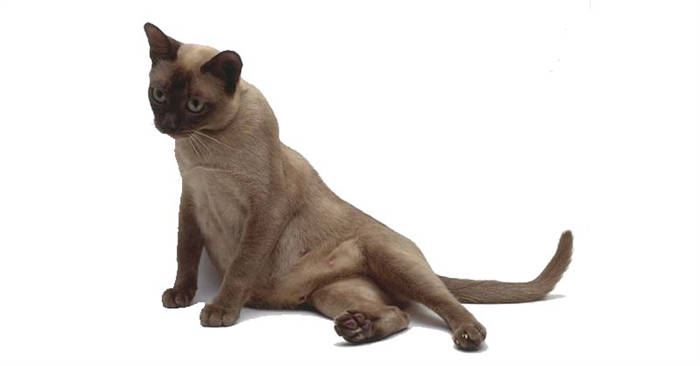
The young mother's body begins milk production. As lactation begins, the cat's mammary glands become denser and increase in size. When touching, you may notice a discharge of clear or creamy fluid. This discharge does not look like milk, as the first time (1-3 days) the cat feeds the offspring with colostrum.
Note! A few days before labor, you may notice that the cat has begun to wash her belly more thoroughly – this is also a sign that lactation has begun.
All cats go through the stages of nest building. The timing can vary from 2 weeks to 2 hours before labor. The cat settles on the bottom shelf of a closet with clothes, the space under the bed, or another secluded corner. To make caring for kittens easier, prepare a nest for her in advance and place it in a quiet, comfortable place for the cat.
Symptoms to watch out for
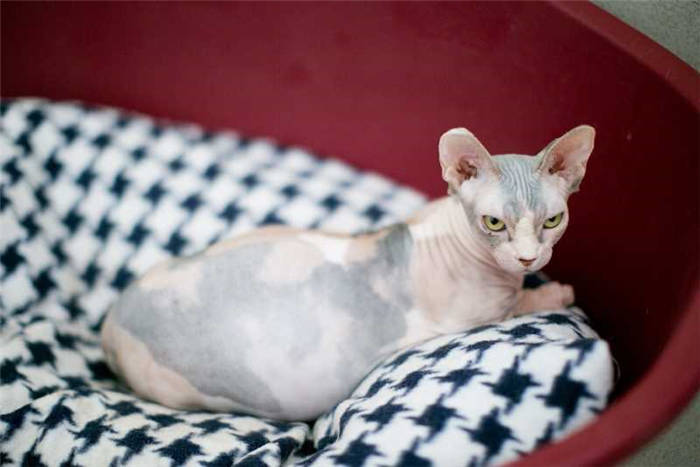
A cat owner with no veterinary training often does not know how to act when alarming symptoms appear. For this reason, you should get a veterinarian's phone number before giving birth, so you can quickly consult with him or her and take action if necessary.
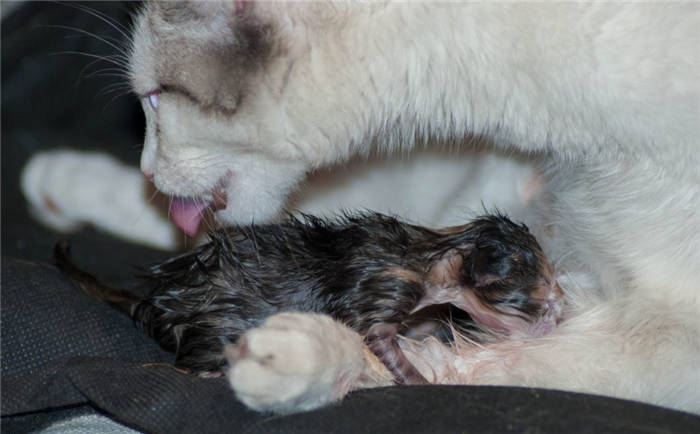
- The labor started too early. Early labor is usually caused by a frozen pregnancy, trauma, fetal abnormalities, placenta detachment. Labor proceeds quickly, and, as a rule, the cubs are born dead. Sometimes only one embryo is born prematurely, and the rest of the offspring are born on time. The causes of miscarriage can only be found out with the help of a specialist.
- Prematurity. When an animal's labor does not begin even on day 70, this may indicate a frozen pregnancy. The veterinarian with a high degree of probability can assume that the kittens died intrauterine. In order to save the mother from intoxication and infection, it is necessary to operate urgently and extract them.
Read also: bleeding in a pregnant cat: what does a bloody discharge in an animal during pregnancy mean and what to do?
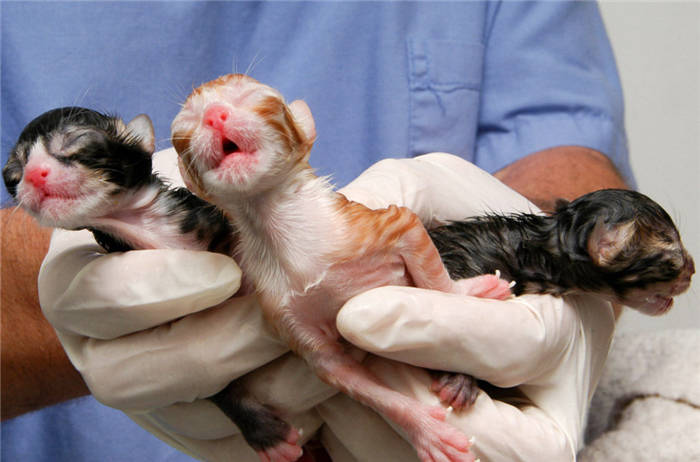
- Cessation of labor activity. During labor, the female may periodically rest. If at the same time she does not leave her seat, refuses to drink and takes care of the newborn without much interest, it means that labor is not over yet. When 3-4 hours have passed since the last baby was born and there is no pushing, you should feel the cat's abdomen. High muscle tone indicates the presence of unborn kittens in the womb. In such a situation, it is necessary to consult a doctor or invite him home.
Help for the pet in case of complications
The greatest complications usually arise during the first birth. The responsibility for the cat and its cubs falls entirely on the owner, so it is necessary to prepare for this process in advance if there is no possibility to invite an experienced veterinarian. To help in the event of complications, the cat owner will need the following medications and devices:
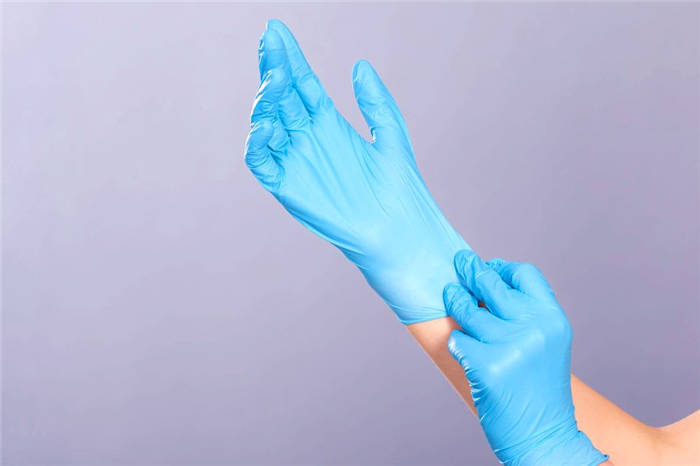
The above remedies should be used only in an emergency situation when labor is difficult. All possible complications and solutions are listed in the table below:
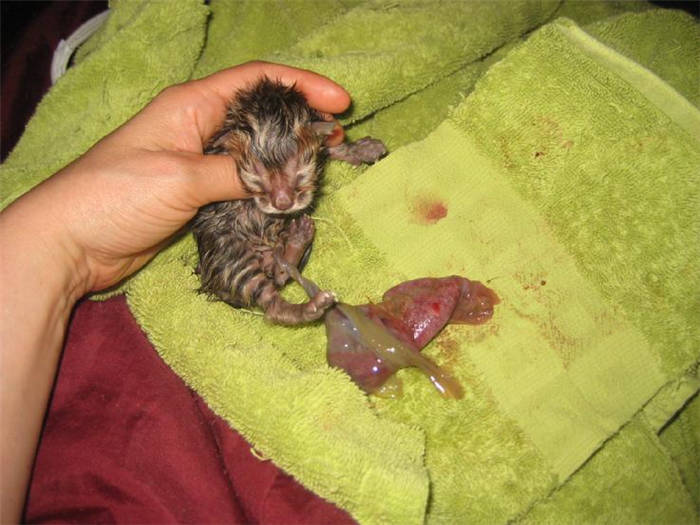
- weak labor activity;
- The fetus is stuck and is not advancing.
- soak a pipette in Levomecol ointment and insert it into the vulva, making circular movements;
- examine the birth canal to see how close the fetus is;
- give an injection of Travmatin or Gamavit in an amount of 1 ml into the withers;
- Stroke the laboring woman's abdomen from top to bottom.
- weak thrusts;
- stop the pushing after the baby's head appears.
- treat the cat's genitals and birth canal with Vaseline, as well as the baby's head.
- administer an injection of Gamavit to the thigh.
- refusal of the cat to chew the bladder within one minute after the birth of the cub;
- the mother is busy with another cub and does not have time to remove the bladder in time.
- cut the bubble tissue with sterile scissors;
- remove the newborn baby;
- remove mucus from the nose and mouth with a pipette or pear;
- wipe the baby with a towel and place it on the mother's stomach.
- lack of interest in the newborn;
- preoccupation with other kittens;
- lack of physical ability to chew the umbilical cord.
Taking care of an expectant mother
Carrying a baby takes a lot of energy, so a pet needs help from her owner. Pay attention to nutrition and housing, and don't forget to build a safe "nest" for the impending birth.
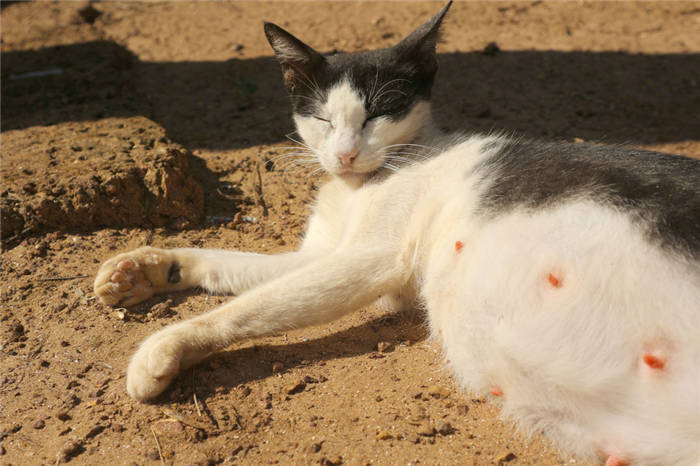
Diet and vitamins
In the first days of increased appetite, the usual norms of feeding increase by 10%. In addition to the quantity of food, it is important to take care of its quality. To give birth to healthy offspring, the pet will need more vitamins and minerals. You can get these from super-premium and holistic dry food specially formulated for pregnant pets.
- Switch to easy-to-digest foods or specialty foods. In the first case, the addition of vitamin and mineral supplements is mandatory, and in the second, it is discussed individually. Check with your veterinarian for exact dosages and brands.
- Increase the frequency of feedings. Do not try to feed an increased amount of food in 2 meals. Have five to six meals a day. From the beginning of the second trimester, the amount of food should be increased twice as much as the original amount.
- Change the water regularly. Do not forget to watch the purity and amount of liquid. Its deficiency or contamination with bacteria may lead to miscarriages.
Do not try to buy vitamins on the advice of friends and acquaintances. This can lead to hypo- or avitaminosis.
Arrange your birthing space
When choosing a place for the "nest" on their own, animals often cram themselves under the couch, preventing their owner from helping them during a difficult labor. Eliminate such a turnaround with your own efforts. Find a safe place on a horizontal and low surface and Position it there:
Accustom your pet to the constructed "nest" from the first days of confirming her position. Soon she will begin to carry soft toys and spend most of her time there.
Is it possible to terminate a pregnancy?
Abortion adversely affects the reproductive function and health of the animal. Veterinarians recommend avoiding it. Surgical abortion with sterilization has the least consequences. It is performed in the first 6 weeks after conception, but it is safer to have it in the first 2-3 weeks. During the operation, the animal's uterus and ovaries are removed.
Self-administration of abortifacients is dangerous, so always seek help from a veterinary clinic. In the presence of a serious pathology, a natural abortion occurs, that is, the fetus dies on its own inside the womb. In this case, the veterinarian should make sure that all kittens are out of the uterus.
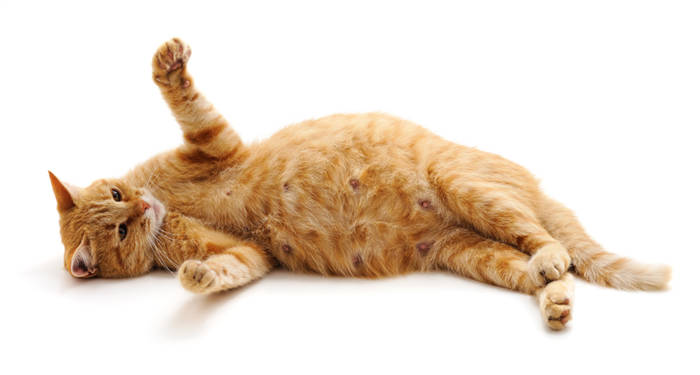
How do you know if something has gone wrong and the animal needs help?
Most often the cat's birth goes well and the animal gives birth on its own. It can happen, however, that your pet needs help both during the calving and after the kittens are born. This has to do with both the physical condition of the cat and her relationship to her own offspring. If a cat is giving birth for the first time, she needs constant attention from her owner.
Discharges after delivery
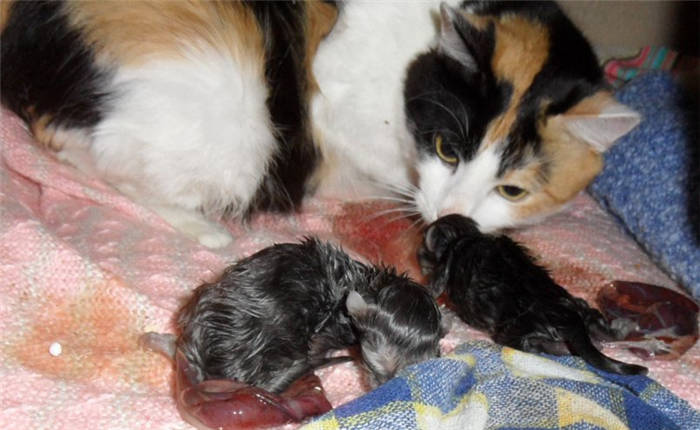
If a cat bleeds profusely for about 10 minutes after it has calved, you should call the veterinarian. This condition is often caused by a ruptured uterus or vulva. Moderate bloody discharge for 2 days after calving is considered normal, as long as there is no foul odor, mucus or pus. If the discharge persists for a long time, a veterinarian should be consulted.
Large belly in a cat that has given birth
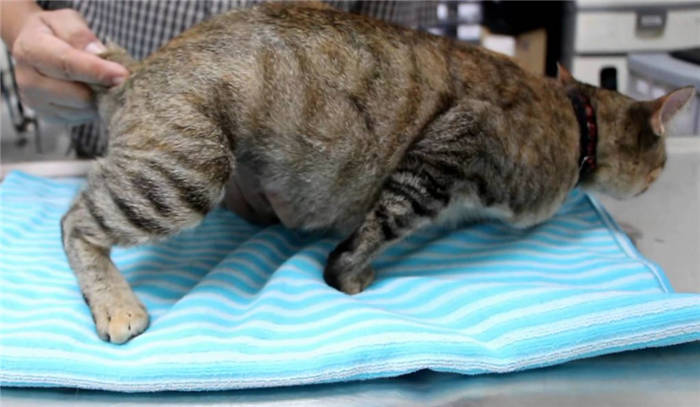
A large belly in a new mother may indicate a build-up of gas and feces caused by constipation, or a worm infestation. Another reason for an enlarged abdomen may be incomplete labor. To find out if the fetus is still in the uterus, you need to palpate the cat's abdomen. When labor is incomplete, the muscles remain tense and the kitten is well palpable. If the baby is moving, you can wait up to 24 hours. If there is no labor activity, the cat should be taken to the veterinarian immediately.
Lack of milk in a cat
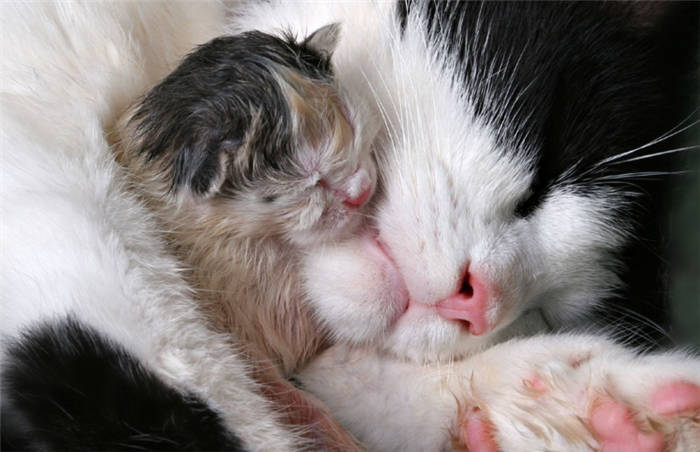
The lack or insufficient amount of milk in a cat that has given birth may be due to stress or aggression of the new mother. The owner should create a calm atmosphere for her cat in which she can express her maternal instinct and feel safe.
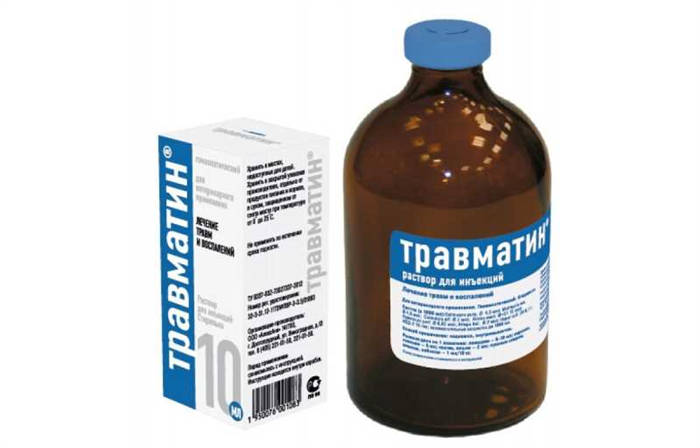
The birth is over. What's next?
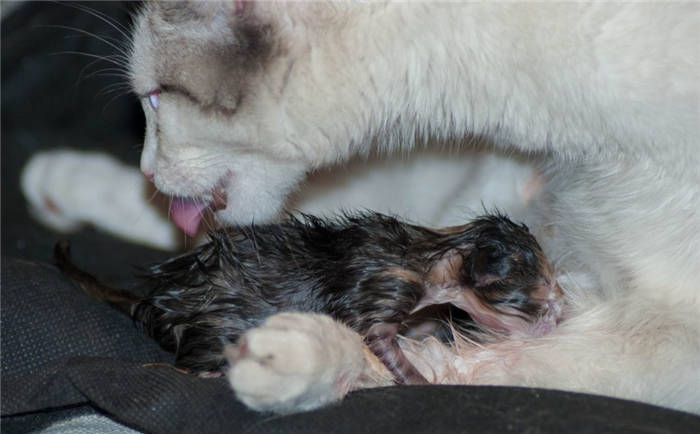
A new mother and her offspring should be well cared for. Need to change the "nest" sheet regularly, it is better to use disposable diapers. If babies suckle little, they should be placed on mother's breast to prevent mastitis.
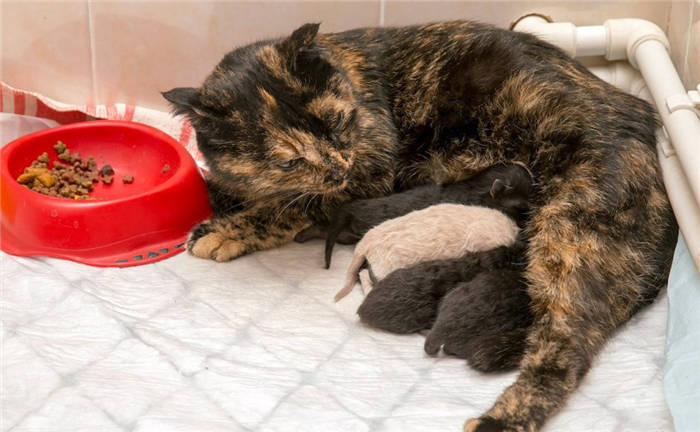
The cat should have access to clean fresh water at room temperature. If the mother ate the afterbirth, she may refuse food for 24 hours. When she gets hungry, you should offer her a small portion of light food (sour cream, kefir, boiled vegetables). You can give some cooked chicken breast. Bone meal (up to 1 tsp. per day), calcium and vitamins should be introduced into the diet of a nursing cat. Dry food should be avoided, because it contains a lot of salts and dehydrates the body. Preferably wet premium food for lactating cats.






